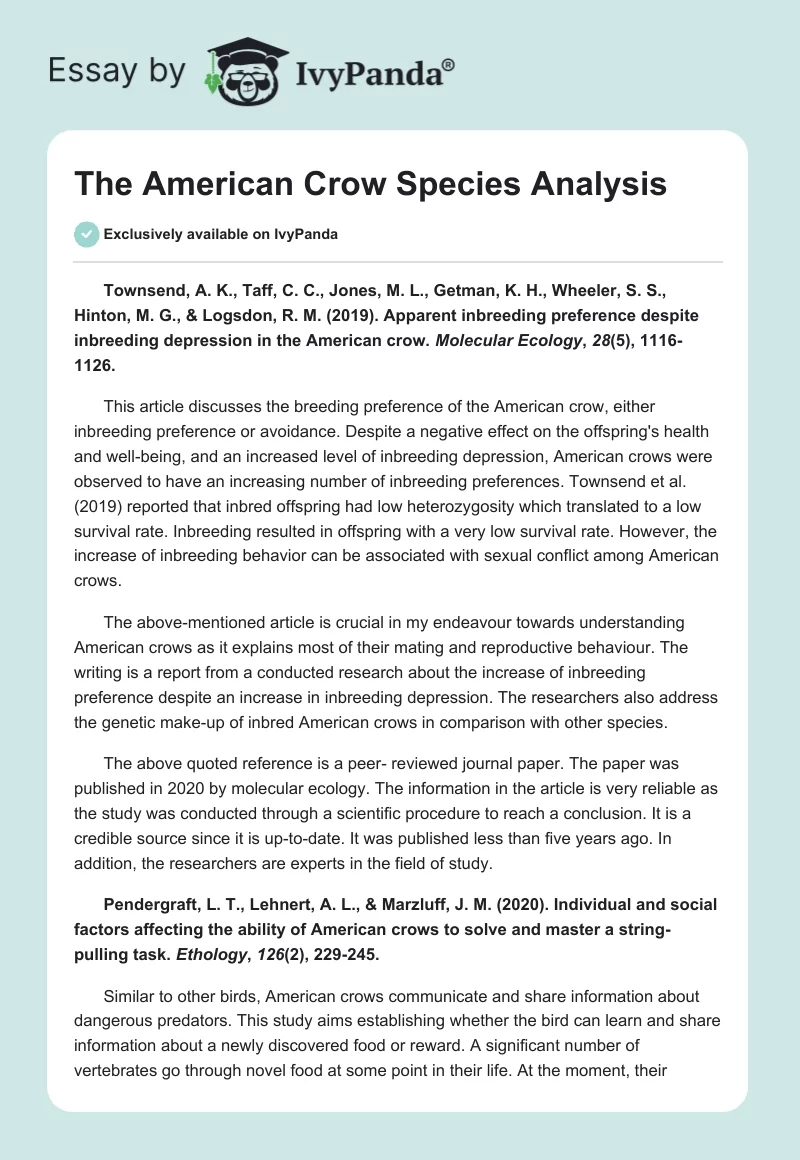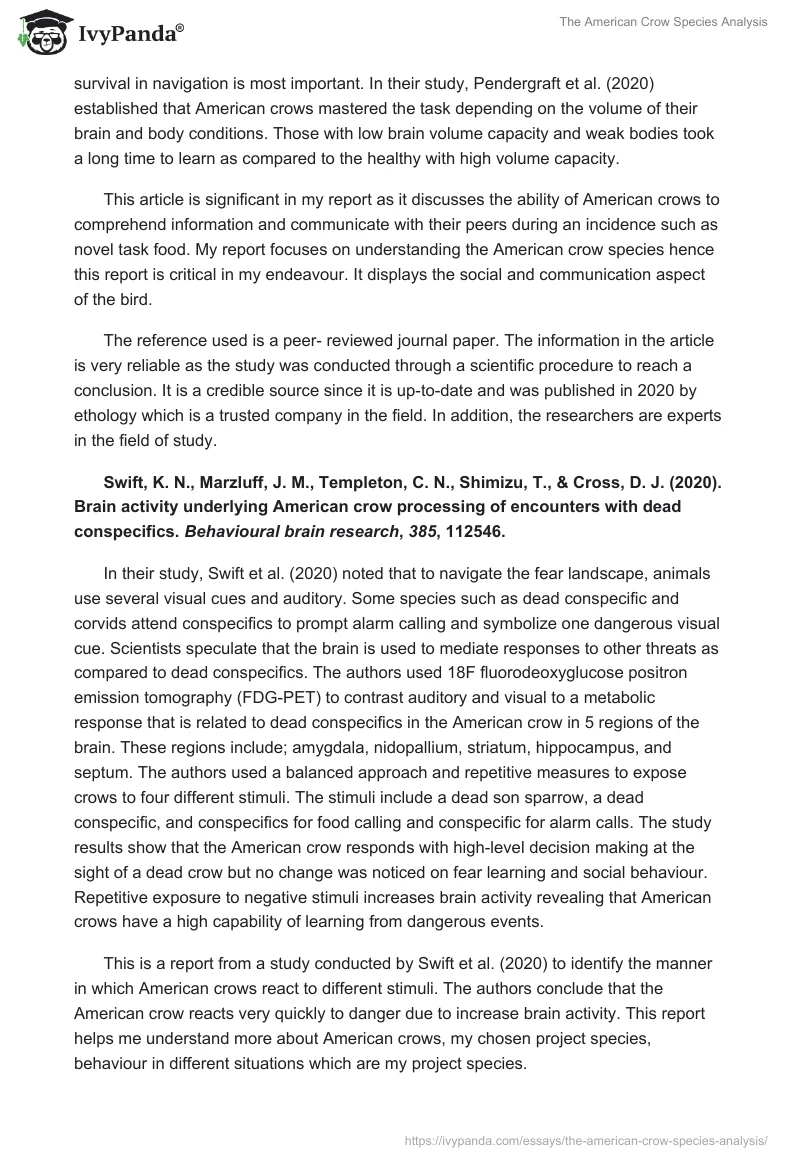Townsend, A. K., Taff, C. C., Jones, M. L., Getman, K. H., Wheeler, S. S., Hinton, M. G., & Logsdon, R. M. (2019). Apparent inbreeding preference despite inbreeding depression in the American crow. Molecular Ecology, 28(5), 1116-1126.
This article discusses the breeding preference of the American crow, either inbreeding preference or avoidance. Despite a negative effect on the offspring’s health and well-being, and an increased level of inbreeding depression, American crows were observed to have an increasing number of inbreeding preferences. Townsend et al. (2019) reported that inbred offspring had low heterozygosity which translated to a low survival rate. Inbreeding resulted in offspring with a very low survival rate. However, the increase of inbreeding behavior can be associated with sexual conflict among American crows.
The above-mentioned article is crucial in my endeavour towards understanding American crows as it explains most of their mating and reproductive behaviour. The writing is a report from a conducted research about the increase of inbreeding preference despite an increase in inbreeding depression. The researchers also address the genetic make-up of inbred American crows in comparison with other species.
The above quoted reference is a peer- reviewed journal paper. The paper was published in 2020 by molecular ecology. The information in the article is very reliable as the study was conducted through a scientific procedure to reach a conclusion. It is a credible source since it is up-to-date. It was published less than five years ago. In addition, the researchers are experts in the field of study.
Pendergraft, L. T., Lehnert, A. L., & Marzluff, J. M. (2020). Individual and social factors affecting the ability of American crows to solve and master a string-pulling task. Ethology, 126(2), 229-245.
Similar to other birds, American crows communicate and share information about dangerous predators. This study aims establishing whether the bird can learn and share information about a newly discovered food or reward. A significant number of vertebrates go through novel food at some point in their life. At the moment, their survival in navigation is most important. In their study, Pendergraft et al. (2020) established that American crows mastered the task depending on the volume of their brain and body conditions. Those with low brain volume capacity and weak bodies took a long time to learn as compared to the healthy with high volume capacity.
This article is significant in my report as it discusses the ability of American crows to comprehend information and communicate with their peers during an incidence such as novel task food. My report focuses on understanding the American crow species hence this report is critical in my endeavour. It displays the social and communication aspect of the bird.
The reference used is a peer- reviewed journal paper. The information in the article is very reliable as the study was conducted through a scientific procedure to reach a conclusion. It is a credible source since it is up-to-date and was published in 2020 by ethology which is a trusted company in the field. In addition, the researchers are experts in the field of study.
Swift, K. N., Marzluff, J. M., Templeton, C. N., Shimizu, T., & Cross, D. J. (2020). Brain activity underlying American crow processing of encounters with dead conspecifics. Behavioural brain research, 385, 112546.
In their study, Swift et al. (2020) noted that to navigate the fear landscape, animals use several visual cues and auditory. Some species such as dead conspecific and corvids attend conspecifics to prompt alarm calling and symbolize one dangerous visual cue. Scientists speculate that the brain is used to mediate responses to other threats as compared to dead conspecifics. The authors used 18F fluorodeoxyglucose positron emission tomography (FDG-PET) to contrast auditory and visual to a metabolic response that is related to dead conspecifics in the American crow in 5 regions of the brain. These regions include; amygdala, nidopallium, striatum, hippocampus, and septum. The authors used a balanced approach and repetitive measures to expose crows to four different stimuli. The stimuli include a dead son sparrow, a dead conspecific, and conspecifics for food calling and conspecific for alarm calls. The study results show that the American crow responds with high-level decision making at the sight of a dead crow but no change was noticed on fear learning and social behaviour. Repetitive exposure to negative stimuli increases brain activity revealing that American crows have a high capability of learning from dangerous events.
This is a report from a study conducted by Swift et al. (2020) to identify the manner in which American crows react to different stimuli. The authors conclude that the American crow reacts very quickly to danger due to increase brain activity. This report helps me understand more about American crows, my chosen project species, behaviour in different situations which are my project species.
The reference used in this section is a peer- reviewed journal paper. The article contains reliable information as the study was conducted through a scientific procedure to reach a conclusion. It is a credible source since it is up-to-date and was sponsored by a trusted organization, Behavioural brain research. In addition, the researchers are experts in the field of study.


